
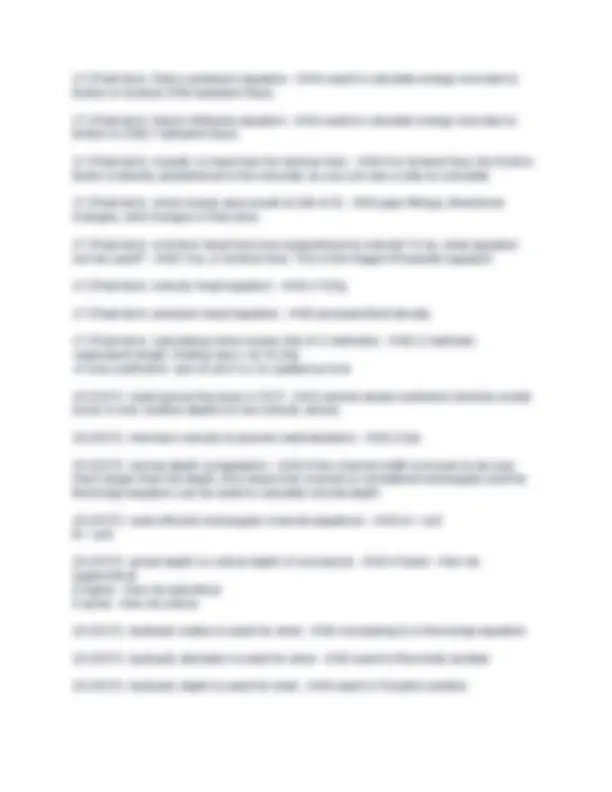
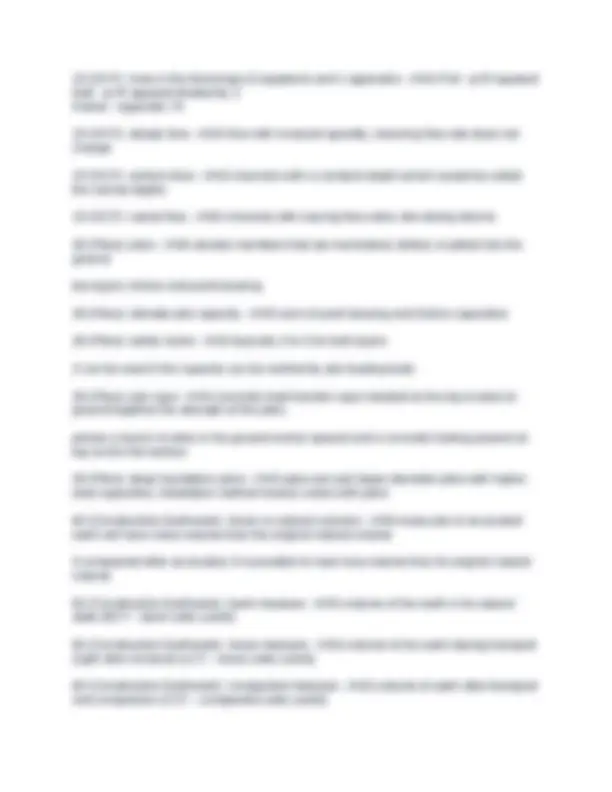
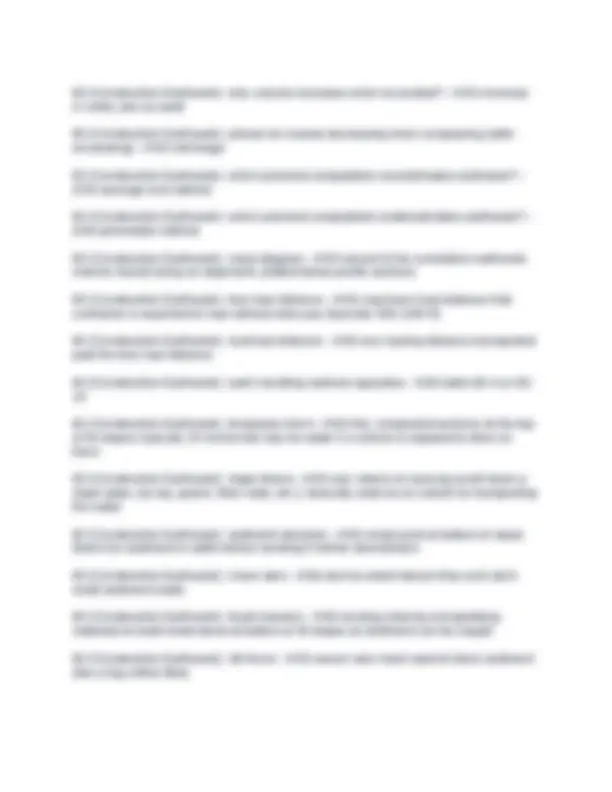
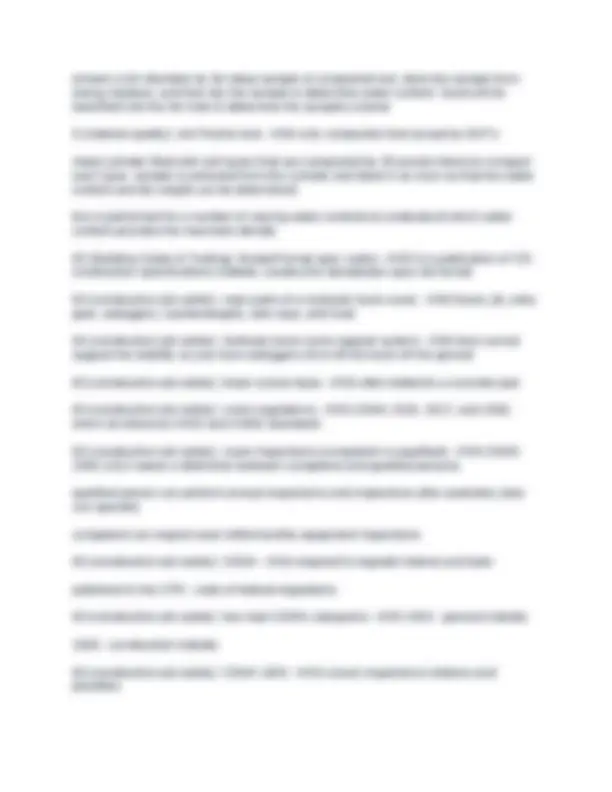
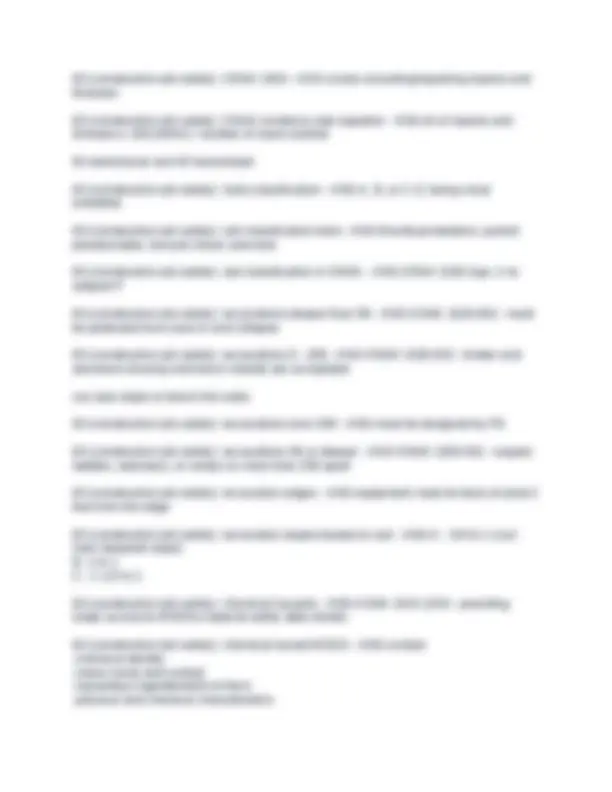
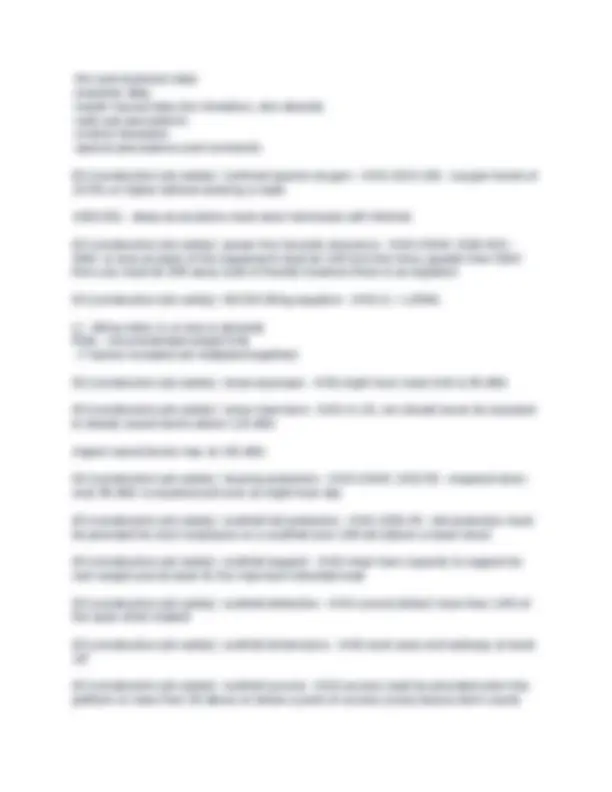
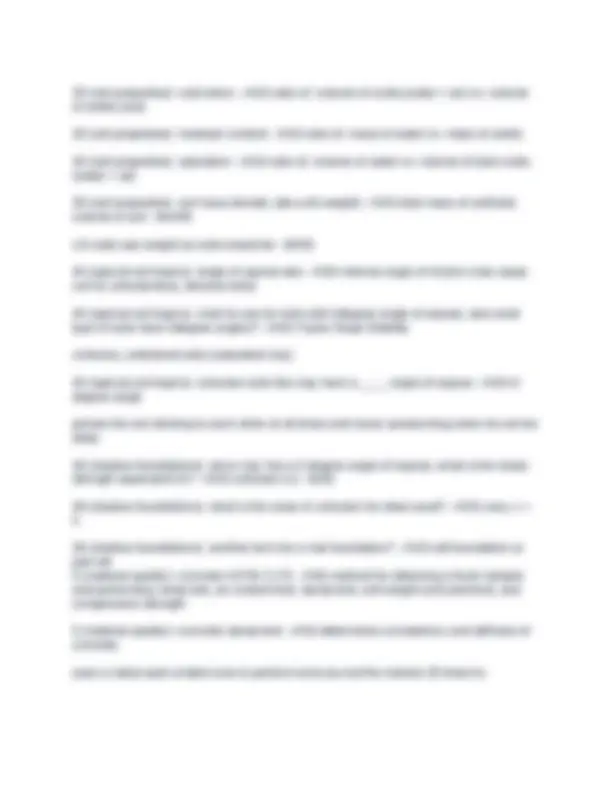
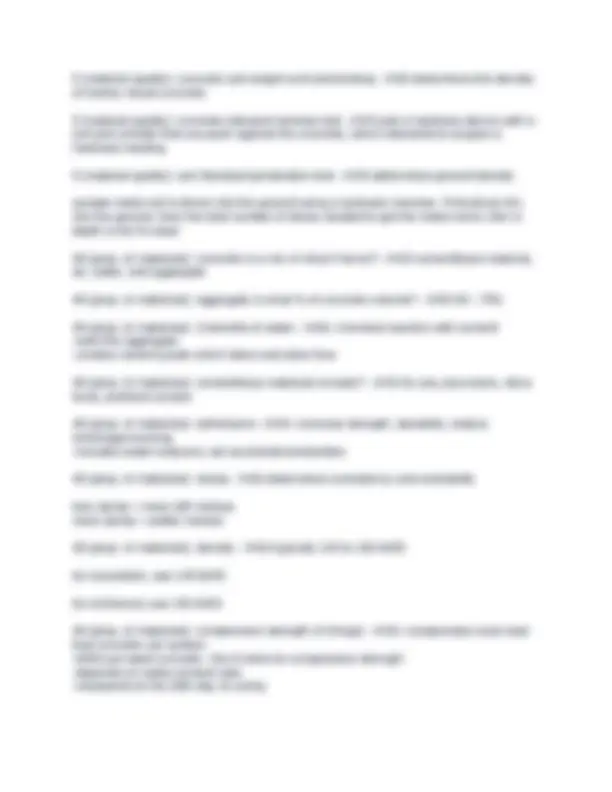
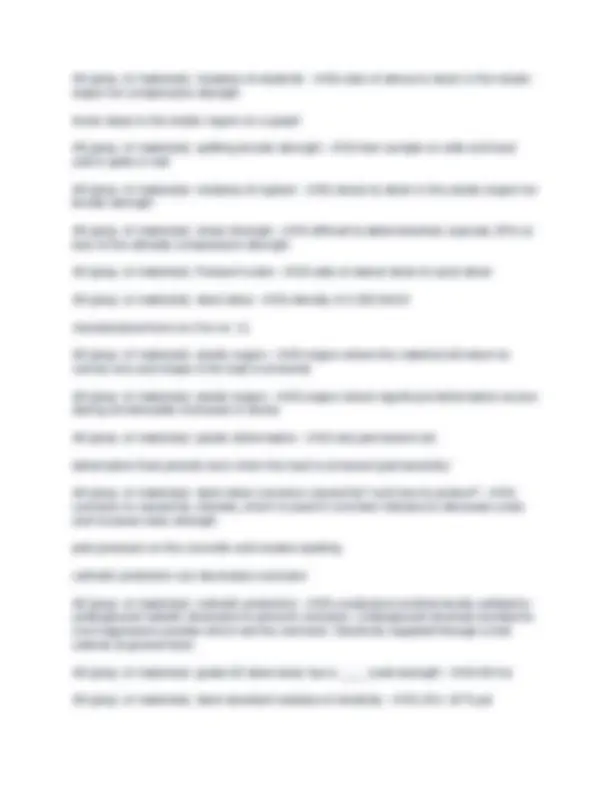


Study with the several resources on Docsity

Earn points by helping other students or get them with a premium plan


Prepare for your exams
Study with the several resources on Docsity

Earn points to download
Earn points by helping other students or get them with a premium plan
Community
Ask the community for help and clear up your study doubts
Discover the best universities in your country according to Docsity users
Free resources
Download our free guides on studying techniques, anxiety management strategies, and thesis advice from Docsity tutors
PE Exam - Construction Depth Questions and Answers
Typology: Exams
1 / 17

This page cannot be seen from the preview
Don't miss anything!










79 (Transpo): Vertical curve turning point definition and equation - ANS-Low point - where catch basins should be installed x(tp) = -G1/R 79 (Transpo): Vertical Curve L equation (length in curve) - ANS-Lsta = EVCsta - BVCsta 79 (Transpo): Vertical curve length for comfort equation (length in curve) - ANS-L = Av^2/46.5 (ALL IN FEET) 79 (Transpo): Vertical curve through points - ANS-Vertical curve with a minimum clearance from an obstruction, curve length should be unknown. Substitute R=A/L as R in the elev(x) equation 16 (Fluids): Bernoulli assumptions (list of 4) - ANS-1. the fluid is incompressible
16 (Fluids): Critical flow Re number - ANS-Critical if between 2100 and 4000 Re 16 (Fluids): Energy grade line (EGL) - ANS-graph of all 3 heads (pressure, velocity, and elevation) always horizontal 16 (Fluids): Hydraulic grade line (HGL) - ANS-graph of 2 heads (pressure and elevation) always at or below the EGL (never above) 16 (Fluids): Specific energy (OCF) equation - ANS-E = pressure energy + potential energy 16 (Fluids): When a pipe is compressed/compacted (by tree root, damage, etc.), the perimeter of the pipe will remain constant. (T/F?) - ANS-True 32 (Env): First flush - ANS-first 15 minutes or first 0.5" of rain during a rain event 32 (Env): 2 compartments in a pond/basin - ANS-1. WQC - water quality compartment
19 (OCF): Area in the Mannings (2 equations and 1 appendix) - ANS-Full - pi R squared Half - pi R squared divided by 2 Partial - Appendix 7A 19 (OCF): steady flow - ANS-flow with invariant quantity; meaning flow rate does not change 19 (OCF): uniform flow - ANS-channels with a constant depth (which would be called the normal depth) 19 (OCF): varied flow - ANS-channels with varying flow rates, like during storms 38 (Piles): piles - ANS-slender members that are hammered, drilled, or jetted into the ground two types: friction and point-bearing 38 (Piles): ultimate pile capacity - ANS-sum of point bearing and friction capacities 38 (Piles): safety factor - ANS-typically 2 to 3 for both types 2 can be used if the capacity can be verified by pile loading tests 38 (Piles): pile caps - ANS-concrete load transfer caps installed at the top of piles to ground together the strength of the piles picture a bunch of piles in the ground evenly spaced and a concrete footing poured on top as the flat surface 38 (Piles): deep foundation piers - ANS-piers are just larger diameter piles with higher load capacities; installation method heavily varies with piers 80 (Construction Earthwork): loose vs natural volumes - ANS-loose pile of excavated earth will have more volume than the original natural volume if compacted after excavated, it is possible to have less volume than its original natural volume 80 (Construction Earthwork): bank-measure - ANS-volume of the earth in its natural state (BCY - bank cubic yards) 80 (Construction Earthwork): loose-measure - ANS-volume of the earth during transport (right after removal) (LCY - loose cubic yards) 80 (Construction Earthwork): compacted-measure - ANS-volume of earth after transport and compaction (CCY - compacted cubic yards)
80 (Construction Earthwork): why volume increases when excavated? - ANS-increase in voids; aka as swell 80 (Construction Earthwork): phrase for volume decreasing when compacting (after excavating) - ANS-shrinkage 80 (Construction Earthwork): which prismoid computation overestimates earthwork? - ANS-average end method 80 (Construction Earthwork): which prismoid computation underestimates earthwork? - ANS-prismoidal method 80 (Construction Earthwork): mass diagram - ANS-record of the cumulative earthwork volume moved along an alignment, plotted below profile sections 80 (Construction Earthwork): free haul distance - ANS-maximum haul distance that contractor is expected to haul without extra pay (typically 500-1000 ft) 80 (Construction Earthwork): overhaul distance - ANS-any hauling distance transported past the free haul distance 80 (Construction Earthwork): earth handling method capacities - ANS-table 80.4 on 80- 10 80 (Construction Earthwork): temporary berm - ANS-flat, compacted sections at the top of fill slopes; typically 24 inches but may be wider if a vehicle is required to drive on them 80 (Construction Earthwork): slope drains - ANS-any means of carrying runoff down a slope (pipe, rip rap, gravel, fiber mats, etc.); basically used as an culvert for transporting the water 80 (Construction Earthwork): sediment structure - ANS-small pond at bottom of slope drains for sediment to settle before sending it further downstream 80 (Construction Earthwork): check dam - ANS-dam to retard stream flow and catch small sediment loads 80 (Construction Earthwork): brush barriers - ANS-reusing clearing and grubbing materials to build small dams at bottom of fill slopes so sediment can be caught 80 (Construction Earthwork): silt fence - ANS-woven wire mesh used to block sediment (like a big coffee filter)
82 (Building Codes & Testing): ANSI - ANS-America national standards institute - does not write standards/procedures but works to approve the standards to avoid other parties from duplicating standards 82 (Building Codes & Testing): testing laboratories (NRTL) - ANS-national recognized testing laboratories recognized by OSHA to perform the material tests written by standard writers biggest of these is UL (underwriters laboratory) 82 (Building Codes & Testing): fire resistivity tests - ANS-ASTM E119 - wall or floor/ceiling assemblies NFPA 252 - door assembly NFPA 257 - windows/glass 82 (Building Codes & Testing): fire dampers - ANS-required in a fire-restive room that has duct if a fire occurs, a fusible link melts to close a louver so the wall rating is maintained 82 (Building Codes & Testing): ADA - ANS-Americans with disabilities act of 1990 82 (Building Codes & Testing): ADA titles (1-5) - ANS-1 - prohibits hiring discrimination (employers w/ 15+ employees) 2 - prohibits public entities from discrimination in programs/activities (transportation) 3 - prohibits private businesses from denying people based on disabilities (ramps, elevators) 4 - telecommunication improvements for speech/hearing impairments 5 - misc relating to format/provisions of ADA and stuff for threats/coercion 5 (material quality): soil dry strength test - ANS-used to determine plasticity. mold a sample into a golf ball size, water it, dry it, then try to break with thumb and forefinger 5 (material quality): soil shaking test (aka?) - ANS-aka dilatancy test form soil sample into 3/4 inch diameter ball, add water until the sample does not stick anymore, then shake the sample vigorously. determined by how fast the water comes to the surface of the ball to make a shiny appearance 5 (material quality): soil sand-cone test - ANS-used to measure the dry density of a compacted soil.
remove a 6in diameter by 6in deep sample of compacted soil, store the sample from losing moisture, and then dry the sample to determine water content. Sand will be backfilled into the 6in hole to determine the samples volume 5 (material quality): soil Proctor test - ANS-only compaction test accept by DOTs metal cylinder filled with soil layers that are compacted by 25 proctor blows to compact each layer. sample is extracted from the cylinder and dried in an oven so that the water content and dry weight can be determined. this is performed for a number of varying water contents to understand which water content provides the maximum density 82 (Building Codes & Testing): MasterFormat spec codes - ANS-is a publication of CSI construction specifications institute, creates the standardize spec list format 83 (construction job safety): main parts of a hydraulic truck crane - ANS-boom, jib, rotex gear, outriggers, counterweights, wire rope, and hook 83 (construction job safety): hydraulic truck crane support system - ANS-tires cannot support the stability so you have outriggers (4) to lift the truck off the ground 83 (construction job safety): tower cranes base - ANS-often bolted to a concrete pad 83 (construction job safety): crane regulations - ANS-OSHA 1910, 1917, and 1926, which all reference ANSI and ASME standards 83 (construction job safety): crane inspections (competent vs qualified) - ANS-OSHA 1926.1412 makes a distinction between competent and qualified persons qualified person can perform annual inspections and inspections after assembly (also can operate) competent can inspect work shifts/monthly equipment inspections 83 (construction job safety): OSHA - ANS-required to regulate federal and state published in the CFR - code of federal regulations 83 (construction job safety): two main OSHA categories - ANS-1910 - general industry 1926 - construction industry 83 (construction job safety): OSHA 1903 - ANS-covers inspections citations and penalties
-fire and explosion data -reactivity data -health hazard data (for inhalation, skin absorb) -safe use precautions -control measures -special precautions and comments 83 (construction job safety): confined spaces oxygen - ANS-1910.146 - oxygen levels of 19.5% or higher without wearing a mask 1926.651 - deep excavations must wear harnesses with lifelines 83 (construction job safety): power line hazards clearance - ANS-OSHA 1926.403 - 50kV or less all parts of the equipment must be 10ft from the lines; greater than 50kV then you must be 35ft away (rule of thumb) however there is an equation 83 (construction job safety): NOISH lifting equation - ANS-LI = L/RWL LI - lifting index (1 or less is desired) RWL - recommended weight limit -7 factors included (all multiplied together) 83 (construction job safety): noise exposure - ANS-eight hour noise limit is 90 dBA 83 (construction job safety): noise maximum - ANS-in US, we should never be exposed to steady sound levels above 115 dBA impact sound levels max at 140 dBA 83 (construction job safety): hearing protection - ANS-OSHA 1910.95 - required when over 85 dBA is experienced over an eight-hour day 83 (construction job safety): scaffold fall protection - ANS-1926.45 - fall protection must be provided for each employee on a scaffold over 10ft tall (above a lower level) 83 (construction job safety): scaffold support - ANS-must have capacity to support its own weight and at least 4x the maximum intended load 83 (construction job safety): scaffold deflection - ANS-cannot deflect more than 1/60 of the span when loaded 83 (construction job safety): scaffold dimensions - ANS-work area and walkway at least 18" 83 (construction job safety): scaffold access - ANS-access must be provided when the platform is more than 2ft above or below a point of access (cross braces don't count)
7 (health and safety): nsc - ANS-national safety council 7 (health and safety): OSHA composition - ANS-the act est. 3 agencies in 1970 -OSHA (administration) -NIOSH - national institute for occupational safety and health -OSHRC: occupational safety health and review commission 7 (health and safety): 3 OSHA agency responsibilities - ANS-OSHA - creates/enforces new safety regulations NIOSH - research agency OSHRC - judicial branch (elected by president) 7 (health and safety): OSHA officers for unscheduled visits - ANS-must have a warrant for unscheduled OSHA inspections; employers have the option to deny 7 (health and safety): OSHA 300 - ANS-injury/illness records 7 (health and safety): OSHA 2203 - ANS-OSHA workplace poster - required 7 (health and safety): OSHA 300A - ANS-Summary of work-related injuries and illnesses 7 (health and safety): OSHA 301 - ANS-supplementary record of injuries/illnesses 7 (health and safety): EMR - ANS-experience modification rate is used by insurance companies to gauge how safe the company is. 1 is considered the industry average. Over 1 means high risk, under 1 means lower risk 7 (health and safety): fire extinguishers placement - ANS-for every 3000ft2, travel distance cannot exceed 100ft, one on every floor, next to stairways 7 (health and safety): NFPA panels for buildings with hazardous chemicals - ANS-top - red - fire left - blue - health right - yellow - reactivity 7 (health and safety): scaffold guardrails - ANS-should be set 39-45in above walking surface and withstand 200 lbf 7 (health and safety): safety nets set at - ANS-provided on jobs 25ft or more off the ground and extend 8ft beyond the edge 3 (operations and methods): 50 minute hour - ANS-used to estimate equipments cycle time; the equipment loses roughly 10 minutes per hour refueling, sitting in traffic, etc.
35 (soil properties): void ration - ANS-ratio of: volume of voids (water + air) vs. volume of solids (soil) 35 (soil properties): moisture content - ANS-ratio of: mass of water vs. mass of solids 35 (soil properties): saturation - ANS-ratio of: volume of water vs. volume of total voids (water + air) 35 (soil properties): soil mass density (aka unit weight) - ANS-total mass of soil/total volume of soil - lbm/ft US units use weight so units would be - lbf/ft 40 (special soil topics): angle of repose aka - ANS-internal angle of friction (max slope cut for cohesionless, drained soils) 40 (special soil topics): chart to use for soils with 0degree angle of repose; also what type of soils have 0degree angles? - ANS-Taylor Slope Stability cohesive, undrained soils (saturated clay) 40 (special soil topics): cohesive soils like clay have a ____ angle of repose - ANS- degree angle picture the soil sticking to each other at all times and never avalanching when its cut too deep 36 (shallow foundations): since clay has a 0 degree angle of repose, what is the shear strength equivalent to? - ANS-cohesion (c) - lb/ft 36 (shallow foundations): what is the value of cohesion for ideal sand? - ANS-zero, c = 0 36 (shallow foundations): another term for a mat foundation? - ANS-raft foundation or just raft 5 (material quality): concrete ASTM C172 - ANS-method for obtaining a fresh sample and performing: temp test, air content test, slump test, unit weight and yield test, and compressive strength 5 (material quality): concrete slump test - ANS-determines consistency and stiffness of concrete uses a metal open ended cone to perform and you rod the mixture 25 times to
5 (material quality): concrete unit weight and yield testing - ANS-determines the density of freshly mixed concrete 5 (material quality): concrete rebound hammer test - ANS-just a hardness device with a rod and cylinder that you push against the concrete, which rebounds to acquire a hardness reading 5 (material quality): soil Standard penetration test - ANS-determines ground density sample metal rod is driven into the ground using a hydraulic hammer. First driven 6in into the ground, then the total number of blows needed to get the metal rod to 18in in depth is the N-value 48 (prop. of materials): concrete is a mix of what 4 items? - ANS-cementitious material, air, water, and aggregate 48 (prop. of materials): aggregate is what % of concrete volume? - ANS-60 - 75% 48 (prop. of materials): 3 benefits of water - ANS--chemical reaction with cement -wets the aggregate -creates cement paste which lubes and allow flow 48 (prop. of materials): cementitious materials include? - ANS-fly ass, pozzolans, silica fume, portland cement 48 (prop. of materials): admixtures - ANS--increase strength, durability, reduce shrinkage/cracking -includes water reducers, set accelerators/retarders 48 (prop. of materials): slump - ANS-determines consistency and workability less slump = more stiff mixture more slump = wetter mixture 48 (prop. of materials): density - ANS-typically 140 to 160 lb/ft for calculation, use 145 lb/ft for reinforced, use 150 lb/ft 48 (prop. of materials): compressive strength (4 things) - ANS--compressive axial load that concrete can sustain -6000 psi rated concrete - the # refers to compressive strength -depends on water-cement ratio -measured on the 28th day of curing
48 (prop. of materials): concrete standard strain when cracking begins - ANS-0.003 in/in 35 (properties of soil): primary mineral components of any soil - ANS-gravel, sand, silt, clay 35 (properties of soil): coarse-grained soils - ANS-sand and gravel 35 (properties of soil): fine-grained soils - ANS-silt and clay 35 (properties of soil): 2 soil classification systems - ANS-AASHTO - American Association of State Highway and Transportation Officials USCS - Unified Soil Classification System 35 (properties of soil): pore pressure above the water table is _____ - ANS-zero 35 (properties of soil): pore pressure below the water table is _____ - ANS-just depth of water table times 62. 35 (properties of soil): effective stress = what - ANS-total stress minus pore pressure 35 (properties of soil): total stress = what - ANS-just depth times the soil density 35 (properties of soil): cone pentetrometer test - ANS-very similar to standard penetration test machine hammer drives a cone shape cylinder into the ground at 2-4ft/min and the resistance is measured 43 (material testing): tensile test - ANS-axially load a specimen and measure its resulting elongation 43 (material testing): stress - ANS-load per unit area (lbf/in2) 43 (material testing): strain - ANS-elongation (in/in) 43 (material testing): the first linear sloped region of a stress-strain graph - ANS- modulus of elasticity (or Youngs modulus, E) 43 (material testing): end of the linear line of a stress-strain graph - ANS-called the proportionality limit 43 (material testing): examples of brittle material - ANS-glass, ceramics, cast iron
43 (material testing): ductility - ANS-material that deforms and elongates a great deal before failure is said to be ductile 43 (material testing): ductile materials - ANS-like steel have the same tensile strength as compressive strength (concrete has higher compressive strength) 43 (material testing): fatigue testing - ANS-repeatedly loading to an amount that is not its ultimate strength and counting the number of times until it fails 43 (material testing): hardness testing - ANS-Mohs test (aka scratch hardness test) - scratch material surface with minerals of known hardnesses 43 (material testing): brittle failures likely occur when.... (3) - ANS-1 - triaxial stress 2 - low temperature 3 - rapid loading 43 (material testing): Charpy test - ANS-testing for material toughness - specimen given a 45 degree notch - basically rapid striking a specimen until it fails with changing heights 43 (material testing): creep test - ANS-